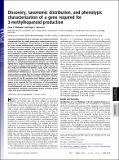Discovery, taxonomic distribution, and phenotypic characterization of a gene required for 3-methylhopanoid production
Author(s)
Welander, Paula V.; Summons, Roger E
DownloadWelander-2012-Discovery, taxonomic distribution and phenotypic.pdf (1.346Mb)
PUBLISHER_POLICY
Publisher Policy
Article is made available in accordance with the publisher's policy and may be subject to US copyright law. Please refer to the publisher's site for terms of use.
Terms of use
Metadata
Show full item recordAbstract
Hopanoids methylated at the C-3 position are a subset of bacterial triterpenoids that are readily preserved in modern and ancient sediments and in petroleum. The production of 3-methylhopanoids by extant aerobic methanotrophs and their common occurrence in modern and fossil methane seep communities, in conjunction with carbon isotope analysis, has led to their use as biomarker proxies for aerobic methanotrophy. In addition, these lipids are also produced by aerobic acetic acid bacteria and, lacking carbon isotope analysis, are more generally used as indicators for aerobiosis in ancient ecosystems. However, recent genetic studies have brought into question our current understanding of the taxonomic diversity of methylhopanoid-producing bacteria and have highlighted that a proper interpretation of methylhopanes in the rock record requires a deeper understanding of their cellular function. In this study, we identified and deleted a gene, hpnR, required for methylation of hopanoids at the C-3 position in the obligate methanotroph Methylococcus capsulatus strain Bath. Bioinformatics analysis revealed that the taxonomic distribution of HpnR extends beyond methanotrophic and acetic acid bacteria. Phenotypic analysis of the M. capsulatus hpnR deletion mutant demonstrated a potential physiological role for 3-methylhopanoids; they appear to be required for the maintenance of intracytoplasmic membranes and cell survival in late stationary phase. Therefore, 3-methylhopanoids may prove more useful as proxies for specific environmental conditions encountered during stationary phase rather than a particular bacterial group.
Date issued
2012-08Department
Massachusetts Institute of Technology. Department of Earth, Atmospheric, and Planetary SciencesJournal
Proceedings of the National Academy of Sciences of the United States of America
Publisher
National Academy of Sciences (U.S.)
Citation
Welander, P. V., and R. E. Summons. “Discovery, Taxonomic Distribution, and Phenotypic Characterization of a Gene Required for 3-methylhopanoid Production.” Proceedings of the National Academy of Sciences 109.32 (2012): 12905–12910. CrossRef. Web.
Version: Final published version
ISSN
0027-8424
1091-6490